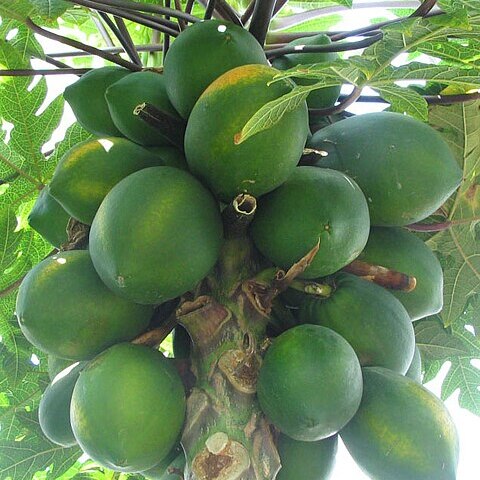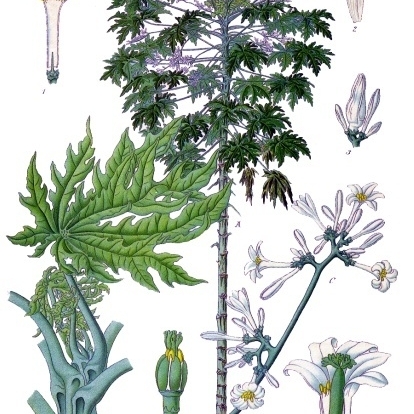Trees small, palmlike, or shrubs, rarely vines, often prickly, monoecious, dioecious, andromonoecious, gynomonoecious, or polygamomonoecious. Stem stout, unbranched, rarely branched, with a terminal cluster of leaves, with flowing, latexlike exudate. Leaves alternate, long petiolate, usually estipulate, large; stipules when present, spiny; leaf blade palmate or palmatifid, rarely entire or pinnatifid. Inflorescences axillary; male flowers aggregated in cymose panicles; female flowers usually solitary or aggregated in corymbose cymes, large. Calyx 5-lobed; lobes small, connate basally. Corolla 5-lobed; tube long in male flowers, short in female flowers. Stamens 5 or 10, 1-or 2-whorled, inserted in throat of corolla tube; filaments free, connate basally; anthers introrse, tetrasporangiate, dehiscing via longitudinal slits. Gynoecium in male flowers vestigial, or absent; in female flowers syncarpous, synovarious to synstylovarious; ovary superior, 1-or 5-loculed, placentation when 1-loculed parietal (placentas ± deeply intruded) or laminar-dispersed, when 5-loculed axile; ovules numerous, anatropous, bitegmic; styles 1 or 5, free to partly joined, apical; stigmas 5, papillate, dry. Fruit large, fleshy, indehiscent berry. Seeds numerous, surrounded by mucilage; endosperm oily; embryo well differentiated; cotyledons 2, broad, flat. n = 9.
Trees [rarely herbs], wood soft, sap milky. Stems erect; usually unbranched. Leaves alternate (borne at branch tips), palmately lobed [simple]; stipules absent; petiole present; blade margins entire or lobed. Inflorescences usually axillary, paniculate [cymose-paniculate, cymose, or racemose]; bracts present. Pedicels present or absent. Flowers usually unisexual, rarely bisexual, staminate and pistillate usually on different plants, 5-merous; calyces rotate, campanulate, or tubular, 5-toothed. Staminate flowers: corolla funnelform [tubular, salverform], tube elongate, 5-lobed, lobes oblong to linear [ovate]; stamens 10, in 2 series, borne at orifice of corolla tube, alternating longer and shorter; anthers dehiscing by longitudinal slits, introrse, distinct or connate basally, connective often projecting beyond anther sacs; ovary vestigial or absent. Pistillate flowers: petals distinct or connate basally, oblong to linear; ovary (1-)5-carpellate, 1-locular; placentation parietal; ovules 100+, anatropous, bitegmic; styles 0 or 1; stigmas 5, divided into 2 or more lobes. Fruits: berries. Seeds brown to black, ovoid to compressed, smooth or warty; aril gelatinous; embryo linear, cotyledons flat, broad.
Trees or shrubs, usually with simple trunks or stems, rarely herbs; milky latex present in all parts. Leaves large, usually clustered at branch tips, long-petioled and exstipulate, variously lobed and divided, glabrous or rarely hairy. Inflorescences axillary or rarely cauliflorous. Flowers dioecious, monoecious or hermaphrodite, pentamerous and regular. Calyx small, gamosepalous, 5-lobed. Male flowers gamopetalous; corolla-tube long and narrow; lobes ± valvate or contorted; stamens 10, biseriate, inserted on the corolla; filaments free or connate. Female flowers with petals ± free; ovary superior, sessile, 1-or 5-locular with parietal placentation; style short or absent; stigmas 5, sessile, simple or fimbriate; ovules numerous, anatropous. Fruit a fleshy berry with numerous seeds; seed with soft succulent outer testa and hard inner testa; endosperm present; embryo straight
Small trees or shrubs with a terminal cluster of leaves and milky juice; leaves alternate, often variously digitately lobed or foliolate; stipules absent; flowers hermaphrodite and unisexual, racemose; male flower: calyx 5-lobed, small; petals united into a slender tube; lobes contorted or valvate; stamens 10, inserted on the corolla; filaments free or connate at the base; anthers 2-celled, opening lengthwise; rudimentary ovary present or absent; female flower: calyx of the male; petals at first connivent, at length free; no staminodes; ovary superior, sessile, 1-celled or spuriously 5-celled, with parietal placentas; ovules numerous; style short or absent; fruit a pulpy berry; seeds with fleshy endosperm and straight embryo
Female flower: petals ± free; ovary superior, sessile, 5-carpellary, 1-locular or 5-locular, with parietal placentation; style short or absent; stigmas 5, connate at the base, entire or lobed
Male flower: corolla gamopetalous, with valvate or contorted lobes; stamens 10, biseriate, inserted on the corolla; filaments free or connate into a short staminal ring
Flowers dioecious, monoecious or hermaphrodite, pentamerous, actinomorphic, in axillary inflorescences or, rarely plants cauliflorous
Trees or shrubs with simple or sparingly branched stems, rarely herbs; milky latex present in all parts
Calyx small, gamosepalous, subentire or 3–5-lobed, the lobes opposing or alternating with petals
Leaves alternate, exstipulate, petiolate, simple and entire or variously lobed or divided
Seeds with succulent outer sarcotesta and hard endotesta; endosperm present
Fruit a fleshy many-seeded berry
Ovules ?, anatropous


